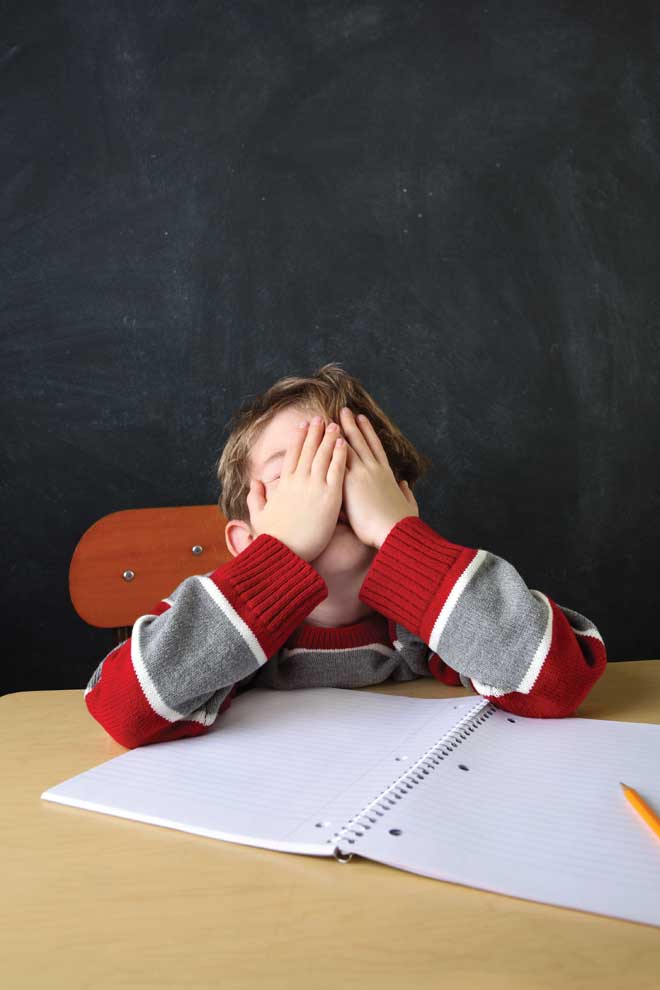Yes, we’re glad they’re headed back to school. But are we ready for all the attendant issues? New shoes and binders are the easy part. What about kids with allergies or attention deficit problems, or those at risk for the latest big concern, concussion? Let’s see what the experts say about getting over some school health hurdles.
[concussion 101]
Concussion has become the newest buzzword in the sports world. But when it comes to head injuries and our kids, that’s personal—and everyone is listening carefully.
hush-hush, no more
“For many years, even at the highest levels of sports, no one talked about concussions. People treated them like they were bruises,” says Dr. Jason P. Young, an orthopedic surgeon at Orthopedic Associates of St. Louis. Not any more.“We have noticed the high rate of exposure for kids. Without a doubt, the attention is all for the better.” An estimated 8.9 percent of high school athletic injuries involve concussions, according to the American Academy of Pediatrics (AAP), with the incidence relatively high in activities not typically considered violent. Dr. Rachael A. Mergenmeier, who practices family medicine at Des Peres Hospital’s MedPost Urgent Care center in Ellisville, says, “With an estimated 300,000 sports-related concussions each year in the U.S., not having a standardized evaluation and recommendations for when kids should return to sports was putting them in danger.”
what is it?
An AAP article, Sports-Related Concussion in Children and Adolescents, identifies concussion as the result of “a direct blow to the head, face or neck, or elsewhere on the body, with an ‘impulsive’ force transmitted to the head.” Concussive injuries “largely reflect a functional disturbance rather than a structural injury,” with injuries not typically detectable by diagnostic images. But the trauma disrupts metabolic and chemical processes, “which results in the depolarization and suppression of neuronal activity.”
the signs
A few seconds of wooziness following a collision on the field can reflect a serious brain injury, Mergenmeier says. “A loss of consciousness makes it easy to recognize a concussion. But there are more subtle things, too, and often student athletes won’t let us know because they want to continue with play.” She suggests a few simple questions: Where are you? Can you count backward by seven? Young adds symptoms to watch for: confusion, dizziness, nausea, light sensitivity or balance problems.
caution counts
At any suspicion of concussion, Young says, “that child needs to be pulled from the sport.” Athletes who finish a game after an impact may encounter their first symptoms hours later, so parents need to remain watchful, he says.
second-impact syndrome
Concussion care emphasizes recovery time. If not fully healed before another impact is suffered, an athlete can be at grave risk. “If we don’t allow healing, the injury goes deeper and affects more body systems,” says Young, who has conducted seminars on sports concussions for coaches. “Second-Impact syndrome can occur even with relatively mild concussions,” Mergenmeier adds, “causing problems with focus, irritability, emotional control, depression, chronic headaches and memory. It can affect future learning.”
riskiest sports
Football incurs the highest concussion rate, according to AAP. Girls soccer is second, followed by boys lacrosse, boys soccer, girls basketball, wrestling, girls lacrosse, softball, boys basketball, boys and girls volleyball, and baseball. “Some others are not often thought of as risky,” Mergenmeier notes, citing hard falls during cheerleading and gymnastics. And, she says, “Girls tend to have more severe and long-lasting sequelae from head injuries.” The AAP paper theorizes that weaker neck muscles and smaller head mass may elevate a girl’s risk.
[by the numbers]
According to the Centers for Disease Control:
> The incidence of ADHD in American children (ages 4 to 17) has risen from 7.8 percent in 2003 to 11 percent in 2011.
> The number of children taking medication for ADHD increased from 4.8 percent in 2007 to 6.1 percent in 2011.
“My professional opinion is that ADHD is not overdiagnosed today,” says Amy Maus, a licensed clinical social worker and assistant director of West County Psychological Associates in Creve Coeur. “Certainly, some children receive poor-quality evaluations and are placed on medication inappropriately.”
“The incidence of ADHD is always a bone of contention,” adds Shelley B. Smith, founder and owner of Special Solutions Private Learning Center in Brentwood. “However, it is very real.”
the roots…The causes of ADHD are uncertain, according to the National Institute of Mental Health (NIMH). Genetics are suspected, as are environmental factors such as childhood exposure to lead and maternal exposure to tobacco and alcohol. “Inattention, hyperactivity and impulsivity are the key behaviors,” states the NIMH. “It is normal for all children sometimes, but for children with ADHD, these behaviors are more pervasive.” The organization identifies three ADHD subtypes: predominately hyperactive-impulsive; predominately inattentive; and combined hyperactive-impulsive and inattentive.
school issues…“I teach parents that ADHD is a neurological condition that impairs an individual’s ability to inhibit behavior and focus attention,” Maus says. “In school, a child needs to be able to sit in the seat, quiet the voice, listen to the teacher, follow directions and organize assignments and materials.”
“These kids have really good intentions but have difficulty following through,” Smith adds. “They are smart, but as demands increase at school, they can’t manage all the tasks. They don’t develop study skills. They have trouble prioritizing. It may not show up until they reach higher level courses. We see medical and law students being diagnosed.”
“The ADHD does not affect their learning,” Smith continues, “but because of missing assignments and poor test-taking skills, their grades aren’t good.”
home issues…The behavior of an ADHD child can be baffling and frustrating for parents. “ADHD can look like laziness, but it’s not,” Smith says. “Being mad at your kid doesn’t work.” Criticism, in fact, may add another layer of difficulty, she notes. “If they do poorly in school and they’re fussed-at all the time, it affects their self-esteem.”
Maus agrees. “It’s important for parents to understand that ADHD is not caused by poor parenting, too much TV, or video games, sugar, caffeine or food additives,” she explains. “What’s important is how parents respond.”
what’s next?…The diagnosis of ADHD often is suggested by a teacher. “Speaking to a private therapist or school counselor is usually a good first step. An evaluation includes psychological testing measures to rule out other causes, such as anxiety, giftedness and depression, and to improve the accuracy of the diagnosis,” Maus says. Medication as treatment can be controversial. NIMH says medications can have a “calming effect” and “reduce hyperactivity and impulsivity and improve ability to focus, work and learn.” However, “a one-size-fits-all approach does not apply.”
“I always encourage parents to keep an open mind,” Maus says. “Every teacher with whom I have worked has witnessed seemingly miraculous results when an ADHD child is provided appropriate medical treatment.”
NIMH also recommends counseling and behavioral therapy. “These children benefit from coaching and role modeling,” Smith says. “Routine is very helpful. We take out their planner and look at what their courses require during the week, and we organize them. We break their time into smaller pieces. We call it ‘chunking.’”
With treatment and ongoing parental encouragement, “They are able to focus their attention, participate in class, complete their assignments and often improve their grades,” Maus says.
[allergies]
Back-to-school coincides with another, not-so-benign season: fall allergies. Unfortunately, St. Louis ranks among the worst places for allergies, says allergist Dr. Robert Kocur.
local l iabilities
iabilities
“In the spring, we have a healthy dose of tree pollen,” Kocur says. “We have a diversity of trees that put out an amazing amount of pollen in March, April and May. Starting around mid-August, the weeds start to pollinate, predominately ragweed, which runs through late September or early October.”
And just as weed pollen settles, our sinuses and airways are attacked again. “The mold, which many people in St. Louis ascribe all of their problems to, will reach its highest counts in late fall as organic matter starts to decompose,” Kocur explains. “The leaves and grass are dying and mold is a by-product of that.”
diagnosis confusion
“The common cold is often confused with allergies, and fall also is the flu season,” notes Dr. Hamsa N. Subramanian of Signature Medical Group. “Allergy symptoms are similar to those for an upper respiratory cold. You have nasal congestion, drainage in the back of the throat, a running nose, coughing and sneezing. Then there are secondary symptoms like headaches and your ears feeling plugged. We have three diagnoses that almost mimic each other, so it is confusing.”
food fights
Food allergies can be a serious back-to-school issue, Subramanian says. “If a child has food allergies, it is the parents’ responsibility to make sure they have spoken to teachers and updated the allergy form at school. They need to see their doctor before school starts so they can renew their emergency medication
prescription and give the doctor time to do the paperwork that is needed by the school.” While school nurses do a great job of monitoring food allergies, “it is very important that parents also watch the lunch schedule,” she says. “If the school is having a party, know what snacks are going to be provided.”
allergy or not?
According to the Centers for Disease Control, an actual allergy “is a hypersensitivity disorder in which the immune system reacts to substances in the environment that are normally considered harmless.”
“We see a lot of non-allergic rhinitis. It behaves exactly like allergies,” Subramanian says. In addition to outdoor irritants such as pollen and mold, nonallergic reactions can be caused by indoor triggers like pet dander, house mite dust, and abrupt changes encountered when going from moist, warm, outside air to cold, dry, inside air, she says.
Children who have asthma—chronic inflammation and narrowing of the airways—also can be affected by stressors such as moving to a new school. So when is it just ‘the sniffles,’ and when do you go to the doctor’s office? “When the symptoms are affecting the child’s quality of life, when they aren’t able to go outside or when it is affecting school performance, it is time for your doctor’s input,” Kocur says.
treatment
Whether symptoms are allergic or non-allergic, physicians have effective tools at their disposal. “We have more variety in medications than we used to, and some are available over the counter,” Kocur says. “If they are following their treatment plans, I do not expect children with allergies to have significantly different lives than children who don’t have allergies.”
“Absolutely,” Subramanian agrees. “I have a motto: ‘Be proactive.’ Have your child evaluated during summer break so you know what to do before that hayride or soccer practice. Know the triggers and know when to take the medications.”








